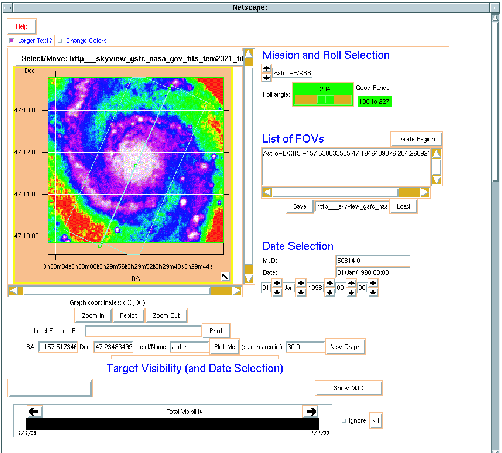 |
This package is designed to accommodate Suzaku specific constraints. These constraints are determined in cooperation of ISAS and GSFC instrument and operations teams. Post-launch changes will be handled in a similar fashion. As has been the case for ASCA, a technician is employed by GSFC and stationed at ISAS to maintain and operate TAKO to produce regular observation schedules.
MAKI is developed at GSFC for Suzaku and future multimission planning5.1. Users may run MAKI through a Web browser (users will need to obtain and install the ``LHEA Plug-In''5.2). Users may place different satellite fields of view on a sky image to plan out observation (Euler angles are automatically calculated). These FOVs may be rotated, and MAKI will indicate if the roll is allowed or not by different colors for a given time period. Users can also view the sun angle visibility limits for several missions, as well as adding phase constraints. MAKI is expected to replace the ASCA command planning program ``adcongra'' which had similar but more primitive functions.
MAKI accepts a sky image file from ``SkyView''5.3, or almost any FITS image files. It also lets users save and reload the results. In figure 5.1, an example of MAKI output is shown.
 |
As of ver. 3.6 released in late 2004, PIMMS calculates expected counting rates for Suzaku.
See details at
http://heasarc.gsfc.nasa.gov/docs/software/tools/pimms.html5.4.
GOF has released a suite of the Suzaku response functions
for spectral simulation purposes. See,
http://heasarc.gsfc.nasa.gov/docs/suzaku/aehp_prop_tools.html
for details.
The ray-tracing package will be used to determine physical parameters of the mirrors which are difficult to measure (e.g., surface densities), by comparing the actual data and simulations. XRT responses such as point spread functions and effective areas will be determined through iterations of the ray-tracing simulations and actual calibration data.
The ray tracing package is also useful to simulate observations when making plans or analyzing data. For example, if there are bright sources outside of the field of view, amounts of the stray-lights can be estimated through the ray-tracing simulations.
A simple simulation with XSPEC does not work in estimating contamination from nearby sources or a position dependent spectrum of extended sources, coupled with the image quality. Such estimates are sometimes necessary for proposing new Suzaku observations or comparing the observing data with the faked data of a complicated model through Monte Carlo simulations. The instrument team has developed the photon-by-photon simulator of XIS events, xissim5.6. The simulator is comprise of two tasks: mkphlist, which fakes incident photons from celestial sources in the XIS FOV, and xissim, which simulates XIS events of the faked photons, taking into account the XRT efficiency and the XIS response. The software outputs photon event files as the real observing data, so uses can analyze the simulated data with the generic XANADU software.